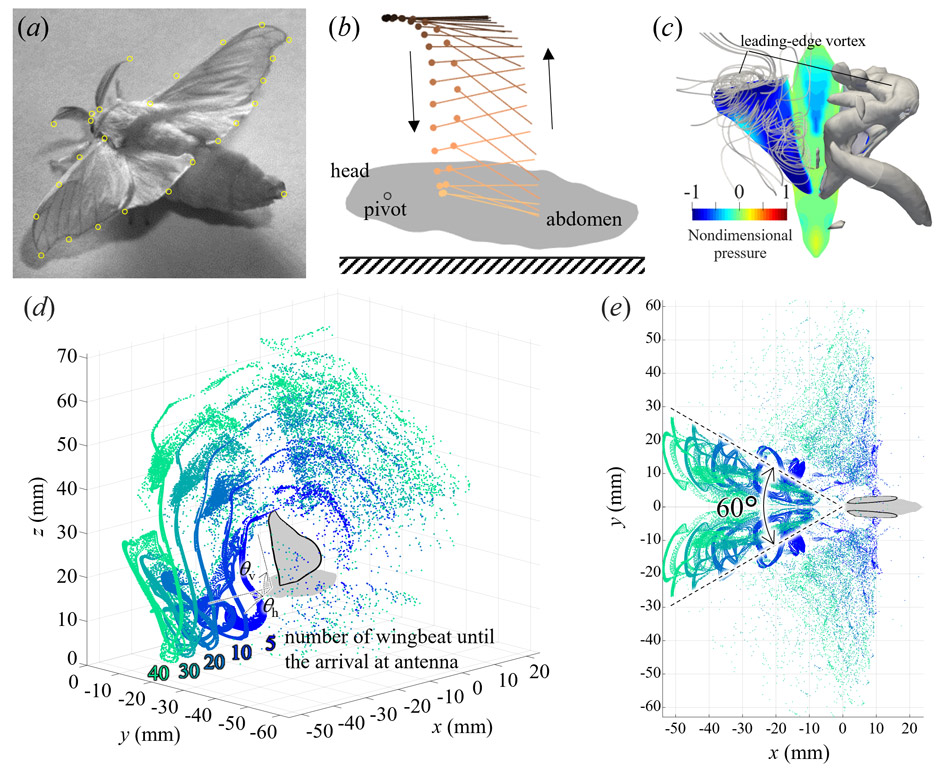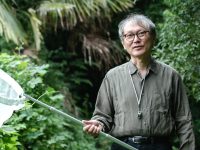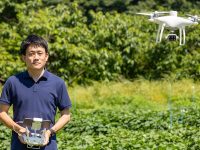Research reveals how wing fanning aids pheromone detection in silkworm moths, offering new insights for odor source localization technologies in robotics
Researchers from Japan explore how the domesticated flightless silkworm moth (Bombyx mori), a prominent insect model in olfactory research, uses wing flapping to manipulate airflow, enhancing their ability to detect distant pheromones. These findings highlight how moths guide pheromones to their odor sensors in antennae, and suggest potential applications for designing advanced robotic systems for odor source localization. This could inspire future innovations in drones and provide design guidelines for robots to locate odor sources.

Image title: Study identifies pheromone detection mechanisms in silkworm moths
Image caption: Particle guidance by the flapping of flightless silkworm moths was quantified by computational fluid dynamic analyses. (a) The flapping silkworm moths were filmed by two high-speed cameras (1,000 fps) to reconstruct (b) the wing kinematics. (c) The flow field around the silkworm moth was simulated by computational fluid dynamic analyses. The typical flow pattern of flying insects, such as leading-edge vortex, was confirmed. (d, e) Based on the flow pattern, the motion of particles that resemble the pheromone molecule has been simulated. The majority of particles reach the antennae from within 60° of the front of the silkworm moth.
Image credit: Toshiyuki Nakata from Chiba University
Image license: CC BY 4.0
Usage restrictions: Cannot be used without permission
The silkworm moth (Bombyx mori) is an insect that no longer flies due to domestication. The males use their antennae to detect pheromones emitted by females and respond very acutely, and have been used as model insects for the study of their odor source localization. Flying insects flap their wings when they fly, and silkworm moths are also known to flap their wings (called fanning) when they detect pheromones, even though they do not fly. As pheromone molecules move through space in the air, the air flows produced by the flapping of wings have undoubtedly a strong influence on odor detection. However, the effect of this flapping of wings was not known quantitatively.
To address this question, a group of scientists led by Dr. Toshiyuki Nakata from the Graduate School of Engineering, Chiba University, investigated how B. mori detects pheromones. “We understand that silkworm moths detect pheromones by flapping their wings to induce airflows around them. However, the precise impact of this wing flapping on the moths’ ability to localize the odor source is unclear,” explains Nakata, while elaborating on the rationale for conducting this study. The team included co-first author, Daigo Terutsuki from the Faculty of Textile Science and Technology, Shinshu University; Chihiro Fukui, from the Graduate School of Science & Engineering, Chiba University; Ryohei Kanzaki, from the Research Center for Advanced Science and Technology, The University of Tokyo; and Hao Liu, from the Graduate School of Engineering, Chiba University.
Their study, published on August 2, 2024, in Volume 14 of Scientific Reports, employed high-speed photogrammetry—a technique that uses high-speed cameras to capture and reconstruct the motion and geometry of objects—to computationally analyze the aerodynamic consequences of wing motions of B. mori. Researchers meticulously recorded the wing movements during fanning and built a detailed computational model of the insects and surrounding airflow. Using the simulated data, they subsequently calculated the motion of particles that resemble the pheromone molecules around the fanning silkworm moth.
One of the key findings of the study was that B. mori samples the pheromone selectively from the front. The moth scans the space by rotating its body while fanning to locate the pheromone sources. The directional sampling of the pheromone molecules is particularly helpful when searching for an odor source since the moth can determine the direction of the odor plume upon the detection of the pheromone.
Needless to say, the implications of this research extend beyond the study of insects. The insights gained from how B. mori manipulates airflow could lead to advancements in robotic odor source localization technologies. A team led by Dr. Daigo Terutsuki is working on developing drones equipped with insect antennae for odor detection, with potential applications such as locating individuals in emergencies. “The findings from this study highlight the importance of creating directional airflow when searching for odor sources using flying robots. This involves carefully adjusting the drone’s orientation and the configuration of its propellers and odor sensors to optimize detection capabilities,” notes Dr. Nakata.
Furthermore, the study highlights the need for future research to consider environmental factors such as airflow turbulence and antenna structure, which also influence odor detection. “Currently, robots rely heavily on vision and auditory sensors for navigation. However, as demonstrated by disaster rescue dogs, utilizing the sense of smell can be highly effective for locating humans. While the application of sensing smell in robots is still in its early stages, this research could help in developing robots that efficiently search for odor sources in disaster situations,” says Dr. Nakata optimistically.
In summary, this study not only advances our knowledge of insects’ odor-detecting strategies but also provides valuable design principles for the next generation of aerial odor-detecting robots.
About Associate Professor Toshiyuki Nakata
Dr. Toshiyuki Nakata is an Associate Professor with a research focus on understanding how flying animals navigate and utilize air to achieve various goals, including efficient long-distance flight and effective localization of food and mates. His work employs advanced engineering tools, including computational simulations and robotics, to investigate these phenomena and develop bio-inspired robots based on his findings. Dr. Nakata is actively involved in several academic societies, including the Japan Society of Mechanical Engineers and the Society of Aero Aqua Bio-mechanisms. His recent research interests include non-flapping flight in insects and birds and the mechanisms of olfactory and auditory navigation in insects.
Funding:
This work was partially supported by the commissioned research fund provided by the F-REI (JPFR23010401), the Japan Prize Heisei Memorial Research Grant, and the Grant-in-Aid for Scientific Research (KAKENHI) Nos. 17K17638, 18H05468, and 24K00829. Additional support came from Grant-in-Aid for Scientific Research (KAKENHI) No. 24K03014, Grant-in-Aid for Scientific Research (KAKENHI) No. 19H02060, JKA Foundation Research Project Number 2024M-419, CASIO Science Promotion Foundation, OSIMO Foundation, Aerial Intelligent Vehicles Programme at Chiba University, Sasakawa Peace Foundation, and Tateisi Science and Technology Foundation.
Reference:
Title of original paper: Olfactory sampling volume for pheromone capture by wing fanning of silkworm moth: a simulation-based study
Authors: Toshiyuki Nakata1, Daigo Terutsuki2, Chihiro Fukui3, Tomoya Uchida4, Kohei Kanzaki3, Taito Koeda3, Sakito Koizumi3, Yuta Murayama3, Ryohei Kanzaki5, and Hao Liu1
Affiliations:
- Graduate School of Engineering, Chiba University, Chiba, Japan
- Department of Mechanical Engineering and Robotics, Faculty of Textile Science and Technology, Shinshu University, Nagano, Japan
- Graduate School of Science and Engineering, Chiba University, Chiba, Japan
- Department of Mechano‑Informatics, Graduate School of Information Science and Technology, The University of Tokyo, Tokyo, Japan
- Research Center for Advanced Science and Technology, The University of Tokyo, Tokyo, Japan
Journal: Scientific Reports
DOI: 10.1038/s41598-024-67966-y
Contacts:
Toshiyuki Nakata,
Graduate School of Engineering, Chiba University
Email: tnakata@chiba-u.jp
Daigo Terutsuki,
Faculty of Textile Science and Technology, Shinshu University
Email: terutsuki@shinshu-u.ac.jp
Public Relations Office, Chiba University
Address: 1-33 Yayoi, Inage, Chiba 263-8522 JAPAN
Email: koho-press@chiba-u.jp
Tel: +81-43-290-2018
Shinshu University: Department of International Affairs
Address: 3-1-1 Asahi, Matsumoto, Nagano 390-8621 JAPAN
Email: intl_ac@shinshu-u.ac.jp
VIDEO INFORMATION
Video title: Scientists from Japan study the mechanisms behind odor detection in silkworm moths
Video caption: Movie showing the iso-surface of Q-value, which represents the surface of vortices. The Q-value is increased from purple to yellow.
Credit: Toshiyuki Nakata from Chiba University
License type: Original content
Usage restrictions: Cannot be used without permission.
YouTube link: https://youtu.be/oKYVpVUCIuM?feature=shared
Video title: Understanding insect behavior could influence the usage of odor-sensing technology in robots
Video caption: The representation shows that in the flow field, the motion of scattered pheromones resembling molecules simulated backward in time, eventually reaches the antenna.
Credit: Toshiyuki Nakata from Chiba University
License type: Original content
Usage restrictions: Cannot be used without permission.
YouTube link: https://youtube.com/shorts/B59KYx9KDAc?feature=shared
Recommend
-

An Insect Enthusiast’s Pursuit: Pesticide-Free Farming for Human-Insect-Crop Harmony!
2023.10.30
-

Predicting Future CO2 Absorption and Emissions in Terrestrial Ecosystems: International Geostationary Meteorological Satellite Network for Accurate Estimation
2023.07.04
-

Making the Invisible Visible: Drones Enabling Agricultural Advances
2022.10.17


